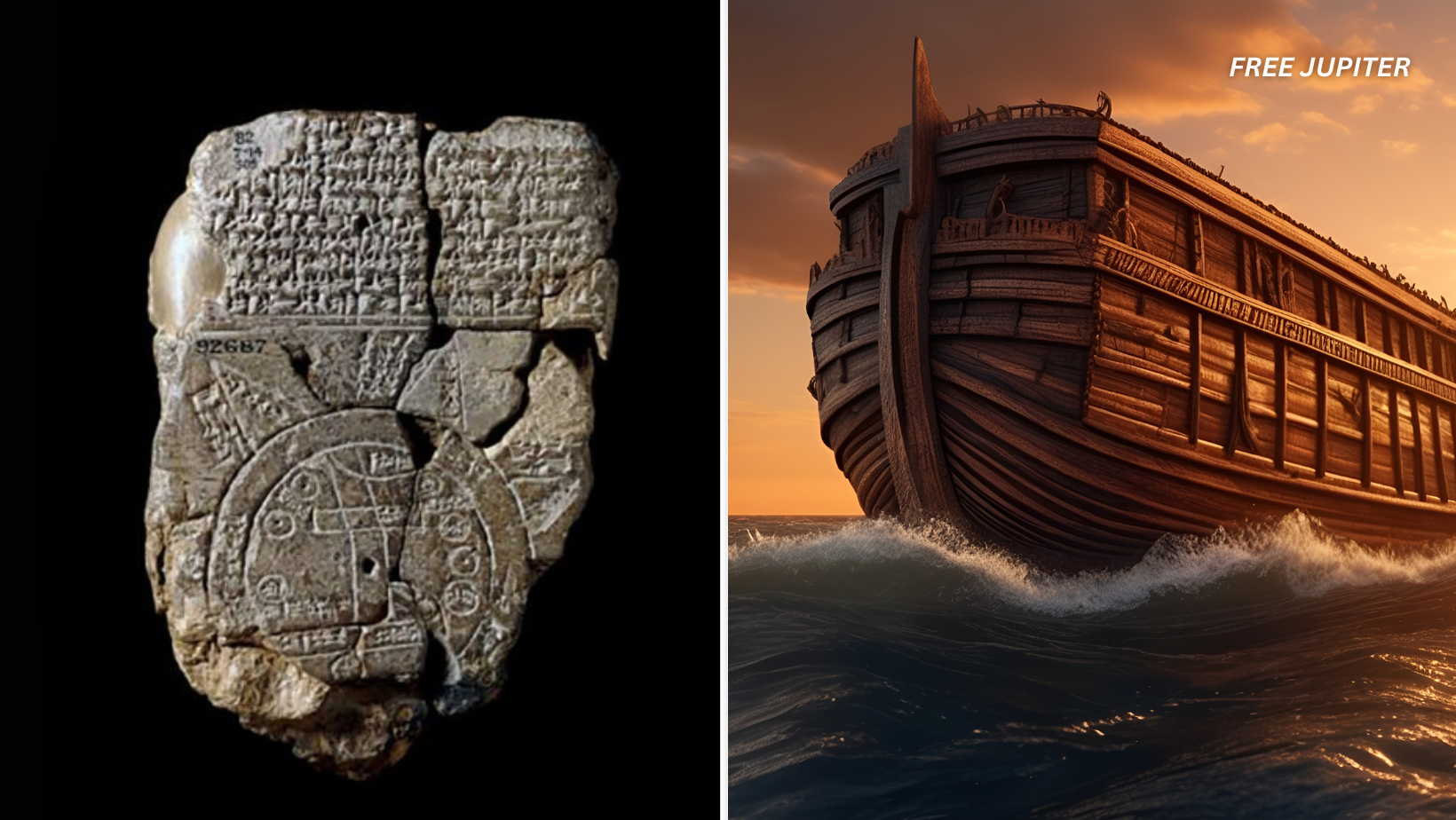A clay tablet created over three millennia ago might hold an unexpected secret: an early reference to the ark from the biblical flood story. The artifact in question, known as the Babylonian Map of the World—or Imago Mundi—has puzzled scholars for generations. Now, a fresh interpretation has sparked renewed interest, suggesting that the tablet might contain the earliest known mention of Noah’s Ark—or at least its Mesopotamian equivalent.
A 3,000-Year-Old Puzzle from Ancient Sippar
Discovered in 1882 by Assyrian archaeologist Hormuzd Rassam in the ruins of Sippar (a city from ancient Babylon, now located in modern-day Iraq), this unassuming clay tablet has spent most of its post-excavation life quietly housed in the British Museum. At first glance, the piece appears modest: small in size, etched with delicate cuneiform script, and bearing what resembles a primitive map.
But for scholars like Irving Finkel, a curator at the British Museum and expert in ancient Mesopotamian languages, this relic has become a window into a forgotten worldview.
“This is one of the most compelling documents we have from antiquity,” Finkel explains. “It encapsulates how ancient people understood their place in the world—and even what they believed lay beyond it.”
Mapping the World Before Maps
The front of the tablet displays what looks like a bird’s-eye view of the known world at the time. The central feature is Mesopotamia, complete with the Euphrates River, the city of Babylon, and other recognizable locations. These are encircled by a double-ringed boundary labeled as the “Bitter River,” a name ancient scribes used for the encircling ocean thought to mark the end of human habitation.
The circular format of the map might seem symbolic or abstract to modern eyes, but it represented the ancient worldview quite literally. To them, the Earth was a flat disc, bordered by an endless ocean, and beyond it—well, things got strange.
“Everything within that double circle was real and familiar. Everything outside of it was part of a realm of myth, rumor, or perhaps aspiration,” Finkel says.
Read more: Experts Say ‘Time Mirrors’ Are Actually A Real Thing: ‘Like Pressing Undo On The Universe’
The Triangle Zones: Beyond the Known World
On the outer fringe of this circular map are eight triangular shapes. These triangles represent far-off regions that lie beyond the Bitter River. What lies within these sections is described on the back of the tablet—and here the narrative drifts into a realm that mixes myth with speculative geography.
According to the tablet, these distant lands were filled with fantastical elements—think enormous birds, impossibly large trees, and forests where gemstones dangled from branches instead of fruit. It’s hard to say whether these stories were based on exaggerated travel tales, religious mythology, or metaphorical teachings. But the imagination is vivid, to say the least.
This reverse side of the tablet reads like a travel manual for the brave or the curious. One passage, in particular, has stirred excitement among scholars. It describes a journey into one of these triangle zones and references a strange object that can only be seen after traveling a distance of “seven leagues.” The explorer, it says, will come upon something “thick as a parsiktu-vessel.”
That word—parsiktu—caught the attention of Finkel and others.
The Ark Connection
The term “parsiktu” is exceptionally rare in cuneiform literature. In fact, it appears in only one other known tablet—and that one outlines a story strikingly similar to that of Noah’s Ark. The tablet in question describes a great flood and a large, boat-like structure constructed to survive the deluge. This ark eventually crashes on a mountainous region located beyond the “Bitter River.”
Finkel believes the Imago Mundi offers a Babylonian precursor to the flood narrative later found in the Hebrew Bible. While the biblical account describes Noah, the earlier Mesopotamian version centers on a man named Utnapishtim, who also builds a massive boat to weather a divine storm.
The overlap between the two stories has long been noted by historians. What’s new here is the suggestion that this ancient map, long thought to be purely symbolic or cosmological, might also serve as a kind of treasure map—one that points toward a literal location where the ark was believed to have landed.
Read more: New Infrared Contacts Let You See in the Dark — Even With Your Eyes Shut
An Explorer’s Guide or Mythic Blueprint?
While modern archaeologists are unlikely to start scaling mountains based on a 3,000-year-old clay tablet, the symbolic value of this interpretation is immense. It suggests that ancient people were not only mapping their world but also mapping their myths—embedding stories into geography and encouraging travelers to explore both the physical and metaphysical boundaries of existence.
“This wasn’t just a myth in their eyes,” Finkel insists. “To the Babylonians, this journey could be undertaken. And if you followed the instructions, you might encounter the remnants of a vessel that carried survivors of the Great Flood.”
What makes the tablet particularly intriguing is how it blurs the line between storytelling and cartography. The triangles on the map aren’t labeled with names like we see on modern globes. Instead, they’re described with narrative fragments—snapshots of what a traveler might find or encounter.
In this way, the map becomes more than a simple geographic diagram. It becomes a storyboard for adventurers, prophets, and dreamers.
A Meeting of Worlds: Myth and Memory
The flood narrative isn’t unique to Babylon or the Bible. Versions of it can be found in cultures from India to Central America. But the Babylonian tablet represents one of the oldest surviving written accounts that ties such a story to a physical place. That’s where the significance lies.
The idea that the Mesopotamians had a “go there and see for yourself” attitude about the ark is remarkable. It suggests that, to them, myths were not abstract tales but records of history. Their maps weren’t just tools of navigation—they were bridges to the past.
And while we may never know exactly what inspired the triangle-zone stories—be it travel tales, celestial observations, or artistic license—their presence on the tablet continues to captivate scholars, artists, and seekers of lost truths.
Decoding a Lost Language of Meaning
Cuneiform tablets like the Imago Mundi remind us of the complexity and sophistication of early civilizations. These weren’t primitive societies drawing crude pictures in clay. These were thoughtful, literate cultures grappling with some of the same existential questions we ask today: Where do we come from? What lies beyond the horizon? And what happens when the waters rise?
Thanks to experts like Finkel, we’re slowly peeling back the layers of these messages from the deep past. Each new interpretation brings us closer to understanding how early humans viewed the world—and how surprisingly connected their stories are to our own.
Read more: Scientists Discover ‘Limitless’ Energy Source That Could Power Our Country for 60,000 Years
Conclusion: A Map That Still Points Somewhere
The Imago Mundi is more than a dusty artifact. It’s a testament to human curiosity, myth-making, and the enduring power of story. Whether or not a giant ark still rests on a mountain beyond a long-forgotten sea is almost beside the point.
What matters is that someone, thousands of years ago, believed it was there—and drew a map to help others find it.
And in doing so, they left behind a trail not just through land and sea, but through the imagination.










